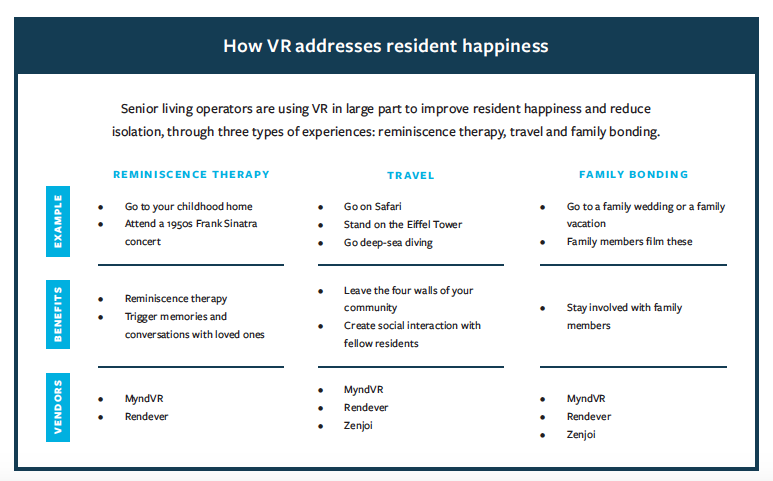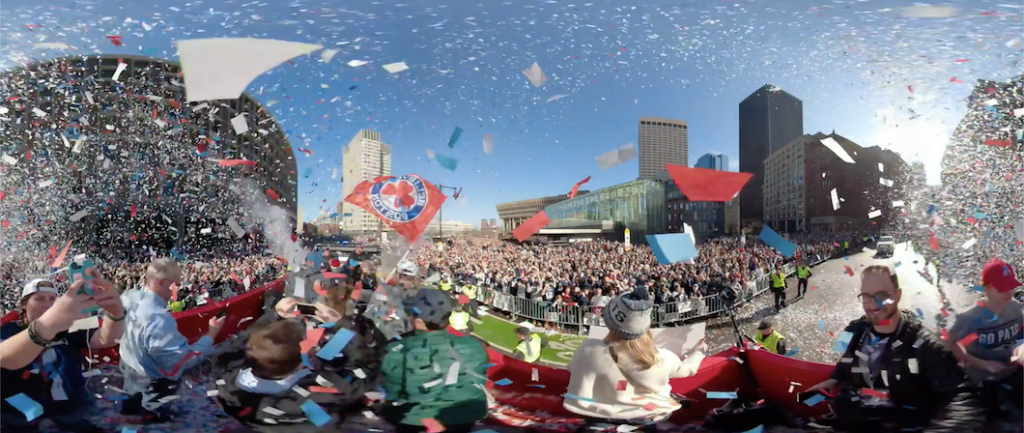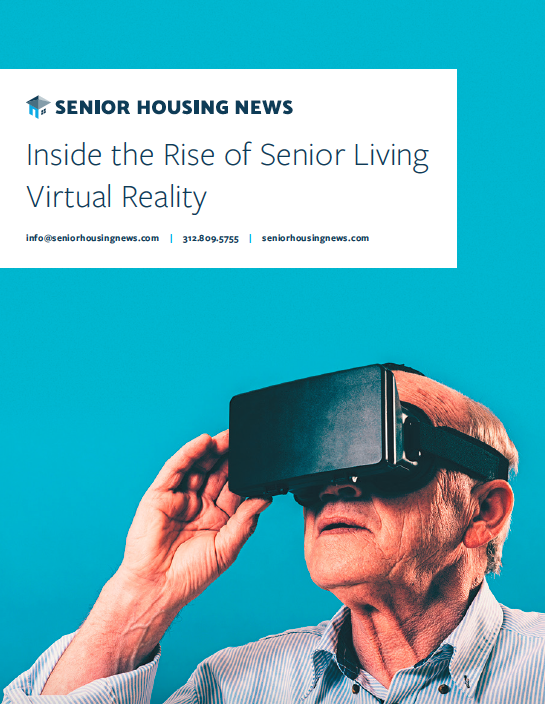After a decade of whispers, trials, pilots and promise, virtual reality (VR) now seems on the precipice of a boom in senior housing and senior care settings.
A bevy of companies have cropped up over the past five years to tailor VR solutions directly to senior living. VR is now helping operators address age-old challenges such as resident isolation, dementia care and pain management, all of which is examined in the new Senior Housing News report, “Inside the Rise of Senior Living Virtual Reality.”
The VR usage expansion is the result of a convergence of trends. For one, boomers are more comfortable with technology than previous generations. Meanwhile, the technology itself is better and more affordable. And shifts in health care are incentivizing prevention and wellness and less reliance on medication, all of which VR can support.
Observing all these trends, operators are beginning to make significant investments both upfront and annually to bring VR to residents and staff. Westport, Connecticut-based Maplewood Senior Living, for instance, spent $104,000 to implement VR in its 13 assisted living communities, with eight headsets per community, and spends $320 per month per community — just under $50,000 annually — on content, training and ongoing support services, working with senior-centric VR company Rendever.
“Residents and their families really love having this as an activity option,” says Brian Geyser, Maplewood’s vice president of clinical innovation and population health. “It’s a social thing. They talk about the experiences later at dinner. To me, it helps with the happiness factor, which is a very important piece of what we offer.”
Resident happiness is one of three main benefits operators are finding with VR, and one of the three explored in the new report, which looks at the experiences of seven senior living operators at different points in their respective VR journeys, along with five leading VR vendors in the senior space.
Here is a look at the three ways operators are using virtual reality to deliver resident happiness and reduce social isolation.

Creating “physical” travel experiences
The potential impact VR can have on resident happiness is summed up by recent work from AARP. In November of 2017, the organization released a study examining Medicare spending data and found that social isolation among older adults “is associated with an estimated $6.7 billion in additional federal spending annually.”
“VR is a powerful tool for driving social connections in more intimate, immersive ways than traditional media,” AARP Innovations Labs Director Nigel Smith told Senior Housing News via email. “Examples include fostering connections between residents, connections with their caregivers and loved ones living outside of the senior housing setting and connections with strangers in the world. In so doing, VR can address some of the underlying needs of seniors and caregivers.”
There are essentially three different avenues for using VR to address resident happiness, all of which can be thought of as a form of travel.
The first, most basic one is physical travel — using VR to bring residents on journeys or experiences no longer available to them due to their physical capabilities. Vendors are doing this through pre-loaded travel scenarios, as well as original content. VR vendor MyndVR has an episodic series called “A Road to Remember” in which the company spent nine months filming the historic Route 66, which runs from Los Angeles to Chicago. It also films interactive tours of museums and zoos, and did an agricultural series for seniors in Kansas who grew up on or around farms.
“We have residents with limited mobility, or those who are no longer able to travel as they once did,” says Jacqueline Trost, vice president of marketing and communications Bloomfield Hills, Michigan-based American House Senior Living Communities, which is running an experiences program with Virtual Reality Rental. “Virtual reality allows them to have first experiences, or revisit locations and activities they hold near and dear.”
But more than just bringing people on trips they can no longer take, vendors are finding ways to bring people on trips they could never take. One prominent, recent example comes from Rendever’s partnership with Benchmark Senior Living and its community in Norwood, Massachusetts, in the heart of New England Patriots country.
After the Patriots won their most recent Super Bowl on February 3, 2019, Rendever wanted to bring Benchmark residents to the championship parade. Rather than just film it from the crowd, Rendever placed two virtual reality cameras on the Patriots’ parade float.
Residents who would not otherwise be able to attend the parade weren’t just given the “you are there” experience — they were given a “you are on the float” experience. And they did it together: Rendever travel experiences are done as a group, with all the users seeing the same scenes. To Rendever and its clients, that is the key to driving socialization and building intergenerational, communal experiences.
“Our residents were happily and actively engaged in the parade, looking for their favorite players and waving to the fans,” says Benchmark’s community technology specialist Tom Fitzpatrick. “They were in awe with the entire experience.”
Using reminiscence therapy to bring residents to their past
The second type of happiness-based travel is reminiscence therapy, transporting residents to their past. This is particularly important for residents in memory support, for whom the ability to verbalize memories can be limited.
There are two basic ways to deliver VR reminiscence therapy. Rendever is bringing seniors to their childhood homes and neighborhoods through a mix of techniques, such as Google Maps, or translating 2D family photos into immersive images.
MyndVR, meanwhile, is taking seniors to more general places in the past. The content that CEO Chris Brickler is most excited about falls into the reminiscence therapy category, blending memory support with music therapy for people with mild cognitive impairment. Playing music from the past for a person living with dementia can be a powerful form of therapy, so Brickler and MyndVR brought an audio experience into the VR sphere.
Rather than playing a Frank Sinatra song on an iPod for a person with dementia, MyndVR decided in 2018 to bring that person into a Frank Sinatra concert. They hired 35 actors to re-create a 1950s swing-jazz club, including a band playing “Fly Me To the Moon,” and filmed it all from the front row of the concert.
In April, MyndVR launched its MyndVR 2.0 initiative, and as a part of the company’s ongoing work, they are collecting data that they hope will lead to more usage, greater outcomes, greater affordability and eventually Medicare reimbursement. They just completed a national study around memory care, with 50% of participants showing positive reactions to the technology and only 25% responding negatively.
“That blew my mind,” Brickler says. “I didn’t think we would see that level of engagement in memory care, but we did.”
Bringing families together
The third type of travel delivering resident happiness is a form of familial bonding, with programs combating familial separation in two ways.
Among AARP’s newest VR ventures is Alcove VR, an intergenerational virtual reality app the organization launched in a collaboration with Rendever. The app joins seniors and their loved ones together in a virtual room, to let them feel more connected than phone calls or FaceTime sessions.
The second solution is to give VR cameras to family members so that they can film weddings, reunions, vacations and other family gatherings. These events are then stored as part of the content package that residents can watch.
“The industry is starting to realize that virtual reality is an avenue that really supports every single spoke of the senior living wheel,” says Kyle Rand, co-founder and CEO Rendever. “It’s really an avenue that tackles every major problem … and brings this industry into the light as an industry that is adopting tech.”
This article draws from the new report, “Inside the Rise of Senior Living Virtual Reality.” Click here to access the complete report, which includes exclusive pricing data showing what operators are spending on VR, never-before-published data and use cases that are driving these investments and in-depth looks into how operators use VR for resident happiness, resident health and staff retention.
Companies featured in this article:
American House Senior Living Communities, Benchmark Senior Living, Maplewood Senior Living, MyndVR, Rendever, Virtual Reality Rental



